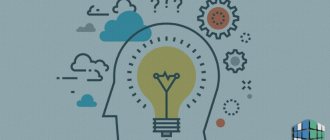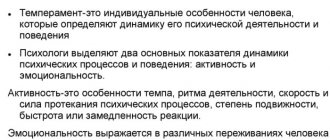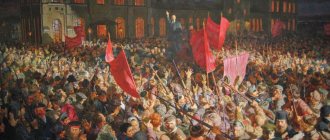Article:
Cognitive processes are the most important part of human activity.
Actually, a person is himself only insofar as he has developed mental cognitive processes. People with impaired or diminished cognition have long been considered inferior, and being labeled as mentally incompetent was considered the greatest shame—much more so than having any physical impairment. Over time, medical terms for mental disability or the diseases with which it is associated have moved beyond the boundaries of science and have become seriously offensive. This shows how much cognitive processes have been valued since ancient times.
Psychology of cognitive processes
The human psyche is a complex structure that ensures the receipt and processing of new information; it allows us to guide human behavior, make correct (as well as erroneous) decisions and creates our inner world. Cognitive processes connect the human person with the real world and allow him to interact with it.
We can say that the entire content of the human psyche is the result of his cognitive activity. The psyche is a reflection of the surrounding world, namely those of its elements with which this person interacted.
To understand the importance of cognitive processes for humans, we should remember which part of the brain is responsible for them. This is primarily the gray matter, which provides higher nervous activity. This structure is a distinctive part of the vertebrate brain, and the proportion of gray matter has steadily increased as evolution has progressed. In lower vertebrates (fish, amphibians), gray matter occupies a small part of the brain and acts as a kind of superstructure that contributes to better survival of the animal. But in higher primates, including humans, the gray matter is the main part of the brain, compared to which the more “ancient” parts are small in size. These highest representatives of the animal world are also distinguished by an extremely high level of mental cognitive processes. Cognizing reality and managing it from a “pleasant bonus” has turned into a vital necessity and the main type of mental activity.
Violation of cognitive processes really makes a person, to one degree or another, inferior and dependent. Mild impairments do not allow a person to take a worthy place in society, get a good job and achieve an acceptable standard of living. And more serious violations can even threaten physical health and life.
Cognitive sphere as a systemic education
Perception is a holistic reflection of objects or phenomena in the human mind with their direct impact on the senses.
Only people and higher animals are endowed with the ability to perceive the world in the form of images; it is formed and improved in their life experiences.
Unlike sensations, perceptual processes form an image of a complete object, reflecting the entire set of its properties. Thus, perception is not reduced to the sum of individual sensations, but represents a qualitatively new stage of sensory perception with its inherent characteristics.
The main characteristics of perception are objectivity, integrity, constancy and meaningfulness, and selectivity.
Objectivity is a person’s ability to perceive the world not as a set of unrelated sensations, but from the point of view of individual objects that have properties that cause these sensations.
The integrity of perception is expressed in the fact that each object is perceived as a stable systemic whole, even if some parts may not be available for observation. In this case, the image of perceived objects is, as it were, mentally constructed into a holistic form based on a small set of elements.
Constancy is defined as the ability to perceive objects as being relatively constant in shape, color and size, as well as a number of other parameters, regardless of changes in the physical conditions of perception.
Meaningfulness is about giving meaning to the objects we perceive. For example, a sentence in a foreign language is difficult to recognize.
Selectivity - out of many different influences, we single out only some of them with greater clarity and awareness. What is in a person’s field of vision during perception is called the object (subject) of perception, everything else is in the background.
Illusions of perception Illusions are a distorted perception of really existing objects or phenomena.
There are different types of illusions. The most common are visual illusions. For example, all light objects appear larger than dark ones.
Artists, performers, and tailors need to know about visual illusions. For example, a tailor sews a dress from striped fabric. If he arranges the fabric so that the stripes run vertically, the woman in this dress will appear taller. And if you place the stripes horizontally, the wearer of the dress will appear shorter and thicker.
One of the variants of such illusions is a mirage. In this case, an object that actually exists in nature is perceived, only the distance to it and its size are estimated incorrectly. The mirage described by K. Flammarion is widely known. One morning in June 1815, residents of the Belgian city of Verviers saw fighting troops in the sky, and one could make out the suits of artillerymen and a cannon with a broken wheel. This was the Battle of Waterloo. Although the distance from Verviers to Waterloo was more than 100 km. Physical illusions are characterized by the fact that they are perceived equally by all people.
Illusions are observed not only in visual perception, but also in other types of perception. Try holding your hand in very cold water and then dipping it in warm water. You will feel as if your hand is almost on top of boiling water.
If you eat a piece of lemon or herring and wash it down with tea with a little sugar, the first sip will seem very sweet.
Physiological illusions occur in people under emotional stress. For example, a person in fear may mistake one object for another (a stump in the forest for an animal or a person).
Hallucinations are perceptions that occur without the presence of a real object. For example, with alcoholic stupefaction, the patient sees dead people around the bed. Sometimes patients think that they see their internal organs: Stomach, brain. Sometimes the patient hears an imaginary voice, usually speaking loudly about the patient's actions, condemning him. The patient may develop a habit of consulting voices.
Structure and functions
Cognitive processes in psychology are considered the “youngest”. Even the centers of these processes are located in the neocortex - the youngest part of the cerebral cortex, with the exception of the centers of attention and memory.
However, these processes are at the same time extremely important for humans, since they perform a number of necessary functions:
- Reception of new information and its differentiation, for which there are different channels of information (visual, auditory, olfactory, etc.).
- Processing primary information and creating holistic subjective images.
- Data storage.
- Establishing connections between different types of sensory information, concepts, images, as well as connections between new information and existing information.
- Creation of concepts and signs, establishment of patterns between phenomena and processes of the surrounding world; signs are also used for communication, which is the basis of speech.
- Creating a strategy of behavior and its motives.
- Formation of goals and long-term objectives of activity.
- The ability to foresee the results of actions and plan one’s behavior.
A person's level of intelligence is determined by how effectively his cognitive processes perform their functions. Understanding the world around us, of course, does not happen spontaneously and chaotically.
It has a certain structure and consists of several stages:
- First, the brain receives new information and processes the received data.
- Then he uses methods of analysis, synthesis, comparison and generalization.
- The information received is remembered and saved.
- From the information received, new information is created - in the form of images and concepts.
- Finally, at the highest level of cognition, complex operations with data, including those of a predictive nature, are carried out.
Types of cognitive mental processes
Cognitive processes did not arise all at once, and different animals are adapted to cognitive activity to varying degrees. Cognitive processes in psychology are divided into lower and higher.
The first group includes sensory-perceptual functions, namely sensations, perceptions and ideas. These processes are available not only to humans, but also to animals; however, if in animals they are the maximum degree of knowledge, then in humans they are only the initial degree. At the same time, these oldest functions of cognition are the most reliable and effective, since they ensure the flow of any information.
The second group includes thinking, imagination, speech and creativity. These are precisely those functions of cognitive activity that are characteristic only of humans. They are organized and managed consciously. Lower cognitive functions make their owner a passive observer of events in the surrounding world, and higher functions allow them to actively participate in these events, change the world and create new ones.
Among the processes of cognition, there are two more, also very ancient in origin and characteristic of even fairly primitive creatures. This is attention and memory. They play a supporting role and serve all other cognitive functions.
Cognitive activity - what is it?
Cognitive activity is the process of assimilation and improvement of knowledge, its continuous increase and development.
This type of activity is inherent only to humans, and belongs to the highest form of mental cognition. It represents a symbiosis of sensory perception, theoretical awareness and practical actions. Accompanying all types of activities, it only at the moment of training acquires a clear, pronounced form and becomes conscious.
The basis of cognitive activity is the process of cognition, as the mental processing and mediation of information, ensuring the acquisition and accumulation of knowledge.
The process of cognition is one of the three processes that make up human consciousness, along with experience and reflection. It is realized through such mental processes as:
- attention;
- memory;
- thinking;
- speech;
- perception;
- sensation;
- performance;
- imagination.
To implement it, the following components are required:
- object (information, knowledge);
- subject (receiving knowledge - cognizing);
- cause-and-effect relationship between subject and object (why it is necessary to acquire this knowledge).
The result of such influence is the acquired knowledge as the fourth component of this process. Knowledge may be true or false, but it is still the result of knowledge.
Classification of cognitive processes
There are quite a lot of cognitive processes, and their primary classification was given earlier. Now it's time to describe them in more detail.
Feel
This is the most primary and primitive type of cognitive processes. These are signals that are perceived by the senses. They give us an idea of the individual properties of objects - temperature, color, sound, taste, etc. Sensations cannot give a holistic picture of the world, moreover, they are momentary: when the contact of the sense organ with the object ends, the sensation disappears.
We usually talk about five types of senses: sight, hearing, taste, smell and touch. Romantics may also try to describe a kind of “sixth sense”. In reality, a person has much more sensations. They are even usually divided into three groups. The first is the same five senses that give the brain information about the outside world. The second group is sensations coming from the internal organs (feelings of hunger, thirst, pain, heartbeat, etc.). The third group is sensations coming from the muscles: data on the position of the body in space, movement, muscle tension, etc.
As a result of experiments, it was even possible to create artificial sense organs that allow a person, for example, to sense an electric field.
The sensations of humans and animals are not the same - both in degree of development and in species. For example, fish have a lateral line - an organ that perceives vibrations and movement of water. The vision of many animals allows them to perceive ultraviolet and infrared rays, but at the same time, some colors that humans see are not available to them.
Perception
This is where actual knowledge begins for a person. After all, sensations in their pure form are most often not recognized by us. The process of perception is also called perception. It allows us to reflect the world in holistic images, although it is still only momentary in nature - we perceive a tree only when we see it.
Perception is also largely related to the senses, just like sensations. Therefore, we can talk about auditory, visual, gustatory, olfactory and tactile images. However, only the first two are the most studied, since vision and hearing are the basis of our understanding and study of the world. But besides them, we also have more complex perceptions: time, movement, space. The latter, of course, is associated with visual sensations, but has its own specifics.
At the same time, perception is a more complex process than just sensations. It is associated with the brain's ability to synthesize and analyze. First, the brain records the impact and distinguishes it from other impacts, then compares it with existing memory images and creates a new holistic image.
Perception is related to human activity and his general mental state. Therefore, in different moods, we perceive the same objects slightly differently. The acuity of perception also depends on sensory experience: the more sensory images are stored in memory, the more diverse the perception is. The owner of rich sensory experience distinguishes a huge number of shades of colors, among the chaotic city noise is able to isolate a specific sound (for example, the singing of a bird), can sense subtle odors and isolate individual components in them.
Representation
These are images of objects or phenomena that do not currently have any effect on our senses. These images are stored in memory and retrieved from there at the right moment - for example, when it is necessary to compare current sensations with past sensory experiences. Representations are also associated with the senses, therefore they can be visual, auditory, motor, etc. But representations are also divided according to their functional content: they can be technical, musical, topographical and others.
Thinking
This is the highest cognitive function, which operates with generalized images and concepts. The result of thinking is the acquisition of new knowledge that cannot be obtained through sensory experience. This process of cognition is based on operations such as analysis, synthesis, comparison and generalization. By comparing various elements of information received (currently or previously), the brain comes to certain conclusions, which are new knowledge, deeper information about the subject.
Thinking is divided into three levels, which a person develops gradually as he grows older.:
- Visual-effective thinking is an elementary type in which mental operations are carried out directly at the moment of physical (objective) activity.
- Visual-figurative – operates with both concrete and abstract images.
- Abstract-logical is the highest level of thinking, which involves tools such as symbols, concepts and signs.
In a modern adult, all three levels are involved in the thought process. However, in young children only visual-effective thinking is developed, while in adolescents visual-figurative thinking also appears. Mental activity developed in the same way in the process of human evolutionary development. It has been established that higher primates also have visual-effective, and sometimes visual-figurative thinking.
Visual-figurative thinking is not the highest level of mental activity, but it is precisely it that is the basis of creativity, which represents the highest stage of the cognition process.
Imagination and creativity
Imagination is responsible for the birth of new images in our brain. Therefore, it is the basis of creativity. Imagination and creativity are already an exclusively human form of mental activity, and it is not found even in higher primates (gorillas, chimpanzees). It is the imagination that is responsible for the creation of our “inner world,” which may not correspond to the external world, but can become the basis for the transformation of this external world.
We can say that with the help of imagination, man has become as detached from nature as possible and immersed himself in creating his own worlds and living in them. At the same time, imagination is part of our nature and a natural result of the development of the human body.
The mechanism of imagination is such that the images we create never exactly correspond to the real ones, even if we imagine what we have repeatedly observed in reality. Elements of previous experience are superimposed on the created image to a certain extent chaotically, even if we try to control this process.
However, images can vary in the degree of novelty and originality, which is why two types of imagination are distinguished:
- Reproductive – responsible for reproducing elements of reality according to a certain pattern. For example, this allows you to imagine an animal from a description, or a mechanism from a drawing. The greater the power of imagination and the amount of available knowledge, the more the created image will correspond to reality.
- Creative – is responsible for creating original images that are absent in reality. But at what point does imagination become creativity? Apparently, this happens when imaginary images are embodied in reality: a sculptor creates a new work, an artist paints a picture, a writer publishes a book, etc. At this moment, the inner world of a person, built by the imagination, seems to invade reality and change it .
Speech
This is also the highest process of cognition. It is believed that articulate speech is only available to humans, although scientific research disproves this: monkeys are able to communicate with each other and with people using “Yerkish” - a specially developed symbolic language, as well as using sign language. Greater primates are even capable of learning these languages on their own and teaching them to each other. Chimpanzees would be quite capable of mastering oral human speech, but the structure of the vocal apparatus does not allow them to do this.
Speech is a system of exchanging information using signs. But this is not just a utilitarian structure, but an important tool of cognition. Logical thinking, which is the highest form of cognition, occurs in speech form; elements of logical thinking are words and other abstract signs.
Speech organizes human thinking and stimulates it. It has been noticed that if a deaf-mute person is not taught a special language, then his thinking will remain at the level of a three-year-old child.
Even the process of perception is connected with speech. Thus, the perceived object must be somehow designated in order to “accept” it in one’s consciousness. And in order to solve a complex problem, it is necessary to identify incomprehensible problems using special words-signs.
Attention
This is nothing more than concentration on objects, phenomena and internal states. Attention is necessary to perceive something specific. At the same time, consciousness at the moment does not notice what is not related to the problem being solved. Attention is an auxiliary process that ensures the functioning of other cognitive functions.
Attention can be involuntary and voluntary. In the first case, a person is attracted to something bright and unusual, that is, certain stimuli. Such concentration does not depend on our efforts and occurs as if “by itself.” And in the second case, concentration occurs purposefully, and attention is fixed on objects that are not of immediate interest. The significance of objects in this case is determined by the goals and objectives of our activities. Complex textbook text or a work process are all less interesting than some kind of entertainment, but we have to focus on them in order to achieve some important goal.
Attention is responsible for the selectivity of our consciousness as a whole. It can even shape human personality: for example, when looking at a beautifully decorated dish, an artist will pay attention to its appearance, a cook will pay attention to the composition of the dish and its nutritional value, and a marketer will pay attention to its possible cost in a restaurant or store.
Memorization techniques
There are techniques designed to facilitate memorization and allow information to be recorded in the brain, converted into combinations of visual images - these are mnemonics.
A fairly effective way to remember information is rhyme and rhythm. This method, which is used in a number of mnemonic exercises, is widely used in advertising. Rhymed information is remembered much faster, is embedded in the memory regardless of desire, and it is often impossible to get rid of it.
Another memorization technique is an abbreviation (acronym). An abbreviation such as IMF, UN, etc. not only shortens long names of organizations, but also helps to remember them.
The method of remembering objects by recording their location came from Greece. A person uses this method quite often, although he is not aware of it. For example, it is difficult to immediately answer the question of how many windows there are in the house where a person lives, but if you imagine that he is walking through his house, then you can count all the windows.
The method of connecting numbers and letters is widely used to memorize numbers. The method helps to translate numbers into words because words have more meaning for a person. The correspondence between numbers and consonants is the basis of this method.
The picture method - the essence is to translate proper names into pictures based on their semantic meaning or sound. This method is especially useful for remembering people's professions and surnames.
To record proper names or just objects in memory, it is quite useful to use chains. To memorize, you need to connect each item from the list with the next one using associations.










